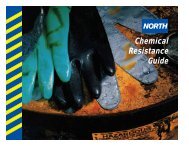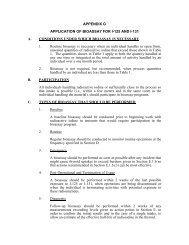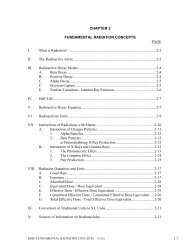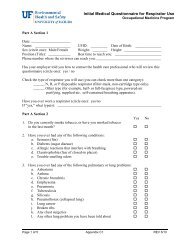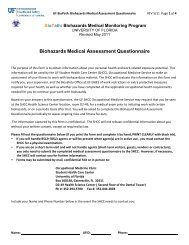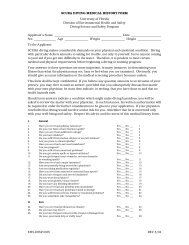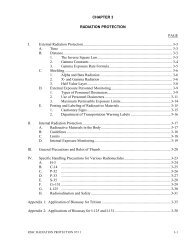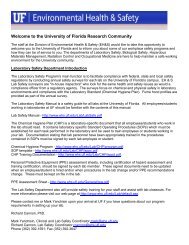Formaldehyde gas kills all microorganisms and spores but not prions. It is used for spacedecontamination and to decontaminate biological safety cabinets. This method <strong>of</strong> decontamination is anextremely dangerous process requiring properly trained, experienced personnel. Formaldehydedissolved in water is active at 1-8% solutions and can be used to decontaminate hard surfaces.However, because formaldehyde is an irritant at low concentrations (0.1 to 5 ppm) and a probablecarcinogen, its use as a hard surface disinfectant is limited to situations in which it is particularly needed.Due to its toxic effects, there are no EPA-registered disinfectants that contain formaldehyde.GlutaraldehydeMost commonly used for high level disinfection <strong>of</strong> medical equipment, e.g. endoscopes. Glutaraldehyde isusually supplied as a 2% solution and requires activation by the addition <strong>of</strong> an alkaline agent prior to use.The activated product may be stored for about 1-4 weeks and should be discarded when turbid.Glutaraldehyde is active against all microorganisms, but is toxic, an irritant, and mutagenic and should beused only when necessary. The manufacturer’s guidance must be followed when using glutaraldehydebasedproducts as there are many different formulations that have been designed for specific uses.Hydrogen peroxideHydrogen peroxide is usually available as a ready-to-use 3% solution or as a 30% solution to be diluted1:5-1:10 to decontaminate work surfaces <strong>of</strong> laboratory benches and biosafety cabinets. It is activeagainst a wide array <strong>of</strong> microorganisms. However, it is a strong oxidizing agent and should not be usedon aluminum, copper, zinc, or brass. Hydrogen peroxide is unstable at high temperatures and in light.Iodine and IodophorsIodine and iodophors are compounds in which the iodine is combined with a solubilizing or carrier agentand are general all-purpose disinfectants with an action similar to that <strong>of</strong> chlorine products. Theappropriate concentration for iodine-containing products is 75 ppm available iodine for disinfecting worksurfaces. Concentrations may be much higher for other purposes. Like chlorine compounds, theeffectiveness <strong>of</strong> iodine compounds may be diminished in the presence <strong>of</strong> protein/organic material.Iodophor compounds that are used for antisepsis (germicide applied to tissue or skin) are not appropriatefor use as hard surface disinfectants and vice versa. Read the product material for appropriate dilutionsand applications.Phenolic compoundsPhenolic compounds are active at 0.2 - 3% concentrations against all forms <strong>of</strong> vegetative microorganismsbut not against spores. They have limited effectiveness against non-lipid viruses and when properlyformulated are anti-mycobacterial. There are many common disinfectants based on phenol and theyshould be used according to the manufacturer’s recommendations.Quaternary ammonium compoundsCompounds in this class are active at concentrations <strong>of</strong> 0.1 - 2%. They are active against vegetativebacteria and lipid viruses, but not against bacterial spores, non-lipid viruses, or tubercle bacilli. Thesecompounds should be used only when a low-level disinfectant is required.Vapor Phase Hydrogen Peroxide Requires specialized equipment Temperature: 4°C-60°C Concentration: 30%, less than 10 mg/liter Non-toxic end products <strong>of</strong> water and oxygen Limited to surfaces, no penetration Corrosive to some materials Degrades natural rubber and nylonChlorine Dioxide gas Dilute chlorine gas and sodium chlorite, less than 25 mg/liter Temp 25°C-30°C, pre-humidification required Limited to surfaces, no penetration Corrosive to some materials Mucous membrane irritant41
Formaldehyde Gas (from heating paraformaldehyde) Kills all microorganisms and spores at temperatures >20°C; not active against prions Temp 20°C-22°C, humidity 70% Conc. 0.3 gm./cu ft. <strong>of</strong> volume Time 6-8 hours Toxic irritant and suspected carcinogen Limited penetration, primarily surface action Requires aeration and time for formaldehyde to <strong>of</strong>f-gas, usually 8 hoursBiomedical and <strong>Biological</strong> WasteTrainingAll employees who generate biological waste or use a sharps box shall be trained regarding the propersegregation, handling, packaging, labeling, storage, and treatment <strong>of</strong> biological waste. Refresher trainingis required annually. Training may be accomplished through the on-line UF Biomedical Waste Trainingprogram. For assistance, please see the training section <strong>of</strong> this manual or call the Biosafety Office at352-392-1591.According to <strong>Florida</strong> Statute (Ch. 64E-16 F.A.C.), records <strong>of</strong> the training session shall be maintained foreach employee, along with an outline <strong>of</strong> the training program. Training records shall be retained for aperiod <strong>of</strong> three (3) years. The training records will be maintained by EH&S and the department.All individuals that generate biological waste must segregate biological waste from other types <strong>of</strong> waste atthe point <strong>of</strong> origin into the following categories:Infectious, Potentially Infectious, Recombinant or Synthetic Nucleic Acid <strong>Biological</strong> WasteWaste items that are, contain, or are contaminated with: Human, animal, or plant pathogens Recombinant or synthetic nucleic acids and recombinant organisms Laboratory and clinical wastes containing human or primate blood, blood products, tissue, cellcultures, and other potentially infectious material (OPIM) including used, absorbent materialscontaminated with blood, blood products, or OPIM or non-absorbent, disposable devices thathave been contaminated with blood, body fluids or OPIM CulturesLaboratory waste containing infectious, potentially infectious, or recombinant or synthetic nucleic acidmolecules must be inactivated prior to leaving the facility. The preferred method is steam sterilization(autoclaving), although incineration or chemical inactivation (e.g. treatment with household bleach) maybe appropriate in some cases. Storage <strong>of</strong> all non-inactivated waste in this category is restricted to withinthe generating laboratory. Infectious or pathogenic waste must be held in a closed/covered biowastecontainer and may not be stored longer than 24 hours prior to inactivation. <strong>Biological</strong> waste containersand bags for material that is infectious/potentially infectious to humans must be labeled with thebiohazard symbol. Filled or partially filled biological waste containers and boxes should not be held formore than 30 days.Non-infectious <strong>Biological</strong> WasteWaste items that are: Used labware (tissue culture dishes and flasks, petri dishes, centrifuge tubes, test tubes, pipettes,vials, etc.) from clinical or biomedical labs that is NOT contaminated with any <strong>of</strong> the biologicalwastes listed in Infectious, Potentially Infectious or Recombinant or Synthetic Nucleic Acid<strong>Biological</strong> Waste category above. This material does NOT qualify for disposal as Clean LabWare. Unused medical devices. This material does NOT qualify for disposal as Clean Lab Ware.42
- Page 1: UNIVERSITYBiosafetyManual2014OFFLOR
- Page 5 and 6: Hurricane Watch ...................
- Page 7 and 8: Authority & ResponsibilitiesBy auth
- Page 9 and 10: All projects involving recombinant
- Page 11 and 12: Tools for Risk AssessmentBoth the N
- Page 13 and 14: The risk assessment will also deter
- Page 15 and 16: assessments and tests/immunizations
- Page 17 and 18: protection of workers and the envir
- Page 20 and 21: Have limited toxicological data app
- Page 23 and 24: Integration of rAAV genomic sequenc
- Page 26 and 27: from fowlpox virus) are most widely
- Page 28 and 29: S+/L- assay: Vector stocks are ampl
- Page 30 and 31: Kenneth Cornetta, Jing Yao, Aparna
- Page 32 and 33: material. The catalyst for increase
- Page 34: Engineering ControlsThese devices a
- Page 38: PPE to protect eyes and face is use
- Page 41: DisinfectantsDisinfectants are chem
- Page 45 and 46: Call Building Services, 294-5500, t
- Page 47 and 48: Autoclave use log must be available
- Page 49 and 50: After the disaster has occurred, de
- Page 51 and 52: Workplace ViolenceAll threats and o
- Page 53 and 54: Account for coworkersWait for any i
- Page 55 and 56: 4. The physician may wish to consul
- Page 57 and 58: Spill Outside the LaboratorySafe tr
- Page 59 and 60: An emergency room should only be us
- Page 61 and 62: staff notifies the PI of any person
- Page 63 and 64: Departments: Assist EH&S in identif
- Page 65 and 66: Investigational New Drug (IND) Vacc
- Page 67 and 68: Transport of Biological Materials o
- Page 69 and 70: All human, animal, or plant pathoge
- Page 71 and 72: Special IssuesHIV Research Laborato
- Page 73 and 74: Symptoms suggestive of B virus infe
- Page 75 and 76: tuberculosis are a potential source
- Page 77 and 78: Table 2. Summary of Recommended Bio
- Page 80 and 81: Table 4: Select Agents and Toxins79
- Page 82 and 83: Table 6: Summary of NIH Guidelines;
- Page 84 and 85: Section Subsection Research Applica
- Page 86 and 87: App C-IVKluyveromyces Host-Vector S
- Page 88 and 89: Table 8: Summary of Biosafety of Vi
- Page 90 and 91: ResourcesBiosafety Resources: http:
- Page 92 and 93:
OCCMEDOPIMOSHAPAPRPIPPEPPQPSDSRACrD
- Page 94 and 95:
ParenteralPathogenPathogenicityPers
- Page 96 and 97:
Plant, Plant Pests, Noxious Weeds,a
- Page 98 and 99:
Select Agent RegulationsAnimal, Ani
- Page 100 and 101:
Transportation RegulationsTransport




